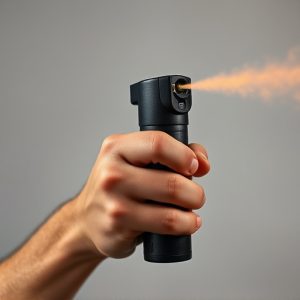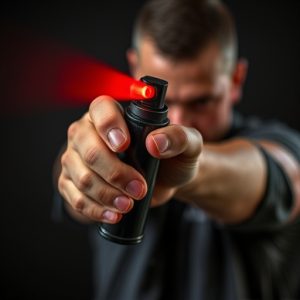Mastering Riot Control: A Guide to Legal Pepper Spray and Dispensers
This text discusses the proper use and legal implications of pepper spray, a non-lethal crowd contro…….
This text discusses the proper use and legal implications of pepper spray, a non-lethal crowd control tool containing capsaicin (1% – 2%). It highlights the strongest legal pepper spray concentration (typically 2% – 5%) permitted globally for safety, focusing on its effectiveness in high-risk situations. The article emphasizes responsible use, detailed protocols, and training requirements, while noting varying legal landscapes and the importance of staying informed. Key features of riot control spray dispensers are also covered, highlighting their role in crowd control and de-escalation during public events to civil unrest.
“Discover the pivotal role of inflammatory riot control spray in law enforcement and crowd management. Our comprehensive guide delves into the intricacies of this powerful tool, offering a detailed ‘Understanding Inflammatory Riot Control Spray’. We explore legal considerations, dissecting regulations surrounding pepper spray use, and shed light on the significance of the strongest legal pepper spray concentration.
Additionally, we analyze key features of effective riot control spray dispensers, their applications, and safety measures, providing essential insights for optimal deployment.”
- Understanding Inflammatory Riot Control Spray: A Comprehensive Overview
- Legal Considerations and Regulations for Pepper Spray Use
- Unlocking the Power: Strongest Legal Pepper Spray Concentration Explained
- Key Features and Design of Effective Riot Control Spray Dispensers
- Applications, Training, and Safety Measures for Optimal Deployment
Understanding Inflammatory Riot Control Spray: A Comprehensive Overview
Inflammatory riot control spray, also known as pepper spray, is a powerful tool used by law enforcement and security personnel for crowd control and self-defense. It’s designed to disrupt an individual’s ability to breathe and cause temporary blindness, rendering them incapacitated for a short period. This non-lethal agent is a popular choice due to its effectiveness in dispersing violent riots and dangerous situations.
The key component in these sprays is capsaicin, the same chemical that gives chili peppers their heat. The strongest legal pepper spray concentration typically ranges from 1% to 2%, ensuring it’s potent enough for crowd control without crossing into illegal or harmful territory. These concentrations can cause intense irritation and coughing fits, making it challenging for rioters to breathe and move effectively. Understanding the proper use and legal implications of these devices is crucial for those in charge of maintaining public safety during high-risk events.
Legal Considerations and Regulations for Pepper Spray Use
The legal considerations surrounding pepper spray, or inflammatory riot control agents, vary greatly by jurisdiction. When discussing the use of such devices, it’s crucial to understand and adhere to local laws and regulations. The strongest legal pepper spray concentration permitted for civilian use is often a key point of regulation. Authorities typically set maximum capsaicin concentrations, measured in parts per million (ppm), to ensure safety and mitigate potential harm. These rules are designed to balance public safety with the right to self-defense or crowd control.
Many countries and states have specific laws governing the sale, possession, and use of pepper spray. Civil liability, such as the potential for damages in case of misuse or accidental injury, is another significant factor. Law enforcement agencies often have detailed protocols for deploying riot control spray, emphasizing responsible use to minimize harm to both suspects and bystanders. Staying informed about these regulations is essential for anyone considering the acquisition or employment of legal pepper spray.
Unlocking the Power: Strongest Legal Pepper Spray Concentration Explained
In the realm of riot control and personal safety, understanding the power of pepper spray is paramount. Unlocking the full potential of this self-defense tool begins with recognizing the strongest legal pepper spray concentration available. This potent substance, when deployed strategically, can provide a crucial advantage in high-risk situations, from crowd control to personal protection.
The key to its effectiveness lies in the active ingredient: capsaicin, derived from chili peppers. The strongest legal concentrations typically range from 2% to 5%, ensuring maximum irritancy and immobilization without causing permanent harm. This concentration allows users to incapacitate attackers temporarily, providing an essential window of opportunity for escape or assistance. By adhering to legal limits, individuals and law enforcement agencies can leverage the power of pepper spray effectively while mitigating potential risks.
Key Features and Design of Effective Riot Control Spray Dispensers
The design and features of riot control spray dispensers are crucial in ensuring their effectiveness during chaotic situations. These devices, often used by law enforcement and security personnel, must be robust and reliable under extreme pressure. Key features include a durable construction capable of withstanding intense use, a precise nozzle for targeted spraying, and a straightforward activation mechanism that can quickly deploy the chemical agent.
Effective riot control spray dispensers are characterized by their highest possible Strongest Legal Pepper Spray Concentration, typically between 2% to 5% capsaicin. This concentration level delivers a powerful sting without causing serious harm, making it legal for use in many jurisdictions. The spray’s formula should also consider factors like weather conditions, ensuring optimal visibility and adhesion, thus maximizing the impact on crowd control.
Applications, Training, and Safety Measures for Optimal Deployment
Inflammatory riot control spray dispensers are versatile tools with a wide range of applications, primarily used by law enforcement and security personnel for crowd control and to de-escalate potentially violent situations. These devices can be employed in various settings, from large public events like concerts or protests to more critical scenarios involving civil unrest or armed individuals. The key advantage lies in their ability to offer non-lethal force, allowing for effective control while minimizing the risk of severe injury.
Training is essential for optimal deployment. Law enforcement agencies should equip officers with comprehensive training on spray dispenser use, focusing on safety and responsible application. This includes understanding the different types of inflammatory sprays, their active ingredients (with an emphasis on the strongest legal pepper spray concentration), and the appropriate distance and angle for deployment. Officers must also learn to recognize de-escalation techniques and when to use the spray as a last resort. Safety measures are paramount; personnel should be equipped with personal protective gear, including eye and face protection, to prevent exposure to the spray. Regular maintenance and inspection of the dispensers ensure their reliable operation during critical deployments.
The effective management of inflammatory riot control spray dispensers requires a deep understanding of both their capabilities and limitations. By navigating legal considerations and selecting the strongest legal pepper spray concentration, appropriate training, and safety measures, law enforcement agencies can harness these tools to maintain public safety in diverse scenarios. Key features and designs of advanced riot control spray dispensers play a pivotal role in optimal deployment, ensuring swift and precise intervention while minimizing harm. Embracing best practices and staying informed about regulations is essential for responsible and effective use.

